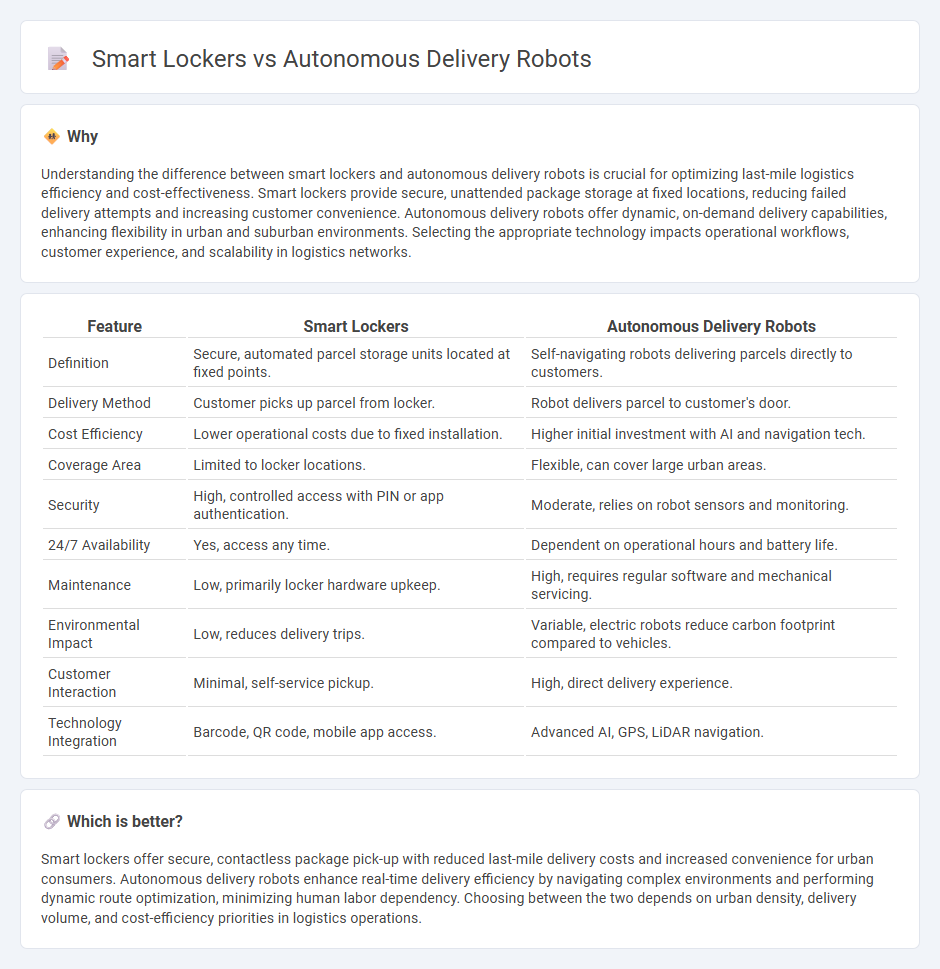
Smart lockers provide secure, contactless parcel pickup points that enhance last-mile delivery efficiency and reduce failed delivery attempts. Autonomous delivery robots offer flexible, on-demand parcel transport with real-time tracking and eco-friendly operation. Explore how these technologies revolutionize logistics for faster, smarter delivery solutions.
Why it is important
Understanding the difference between smart lockers and autonomous delivery robots is crucial for optimizing last-mile logistics efficiency and cost-effectiveness. Smart lockers provide secure, unattended package storage at fixed locations, reducing failed delivery attempts and increasing customer convenience. Autonomous delivery robots offer dynamic, on-demand delivery capabilities, enhancing flexibility in urban and suburban environments. Selecting the appropriate technology impacts operational workflows, customer experience, and scalability in logistics networks.
Comparison Table
| Feature | Smart Lockers | Autonomous Delivery Robots |
|---|---|---|
| Definition | Secure, automated parcel storage units located at fixed points. | Self-navigating robots delivering parcels directly to customers. |
| Delivery Method | Customer picks up parcel from locker. | Robot delivers parcel to customer's door. |
| Cost Efficiency | Lower operational costs due to fixed installation. | Higher initial investment with AI and navigation tech. |
| Coverage Area | Limited to locker locations. | Flexible, can cover large urban areas. |
| Security | High, controlled access with PIN or app authentication. | Moderate, relies on robot sensors and monitoring. |
| 24/7 Availability | Yes, access any time. | Dependent on operational hours and battery life. |
| Maintenance | Low, primarily locker hardware upkeep. | High, requires regular software and mechanical servicing. |
| Environmental Impact | Low, reduces delivery trips. | Variable, electric robots reduce carbon footprint compared to vehicles. |
| Customer Interaction | Minimal, self-service pickup. | High, direct delivery experience. |
| Technology Integration | Barcode, QR code, mobile app access. | Advanced AI, GPS, LiDAR navigation. |
Which is better?
Smart lockers offer secure, contactless package pick-up with reduced last-mile delivery costs and increased convenience for urban consumers. Autonomous delivery robots enhance real-time delivery efficiency by navigating complex environments and performing dynamic route optimization, minimizing human labor dependency. Choosing between the two depends on urban density, delivery volume, and cost-efficiency priorities in logistics operations.
Connection
Smart lockers and autonomous delivery robots are interconnected through automated last-mile delivery solutions that enhance efficiency and convenience in logistics. Autonomous delivery robots transport parcels to designated smart locker locations, enabling secure, contactless, and timely package retrieval by customers. This integration reduces delivery times, optimizes route planning, and lowers operational costs for logistics providers.
Key Terms
Last-mile delivery
Autonomous delivery robots revolutionize last-mile delivery by providing real-time navigation and secure item transport, reducing human labor and increasing efficiency. Smart lockers enhance parcel retrieval by offering contactless, 24/7 access points strategically located in urban areas, minimizing delivery failures and package theft. Explore the latest advancements and comparative benefits of these innovative last-mile delivery solutions.
Contactless pickup
Autonomous delivery robots enhance contactless pickup by navigating directly to customers, minimizing human interaction and reducing delivery time. Smart lockers offer secure, self-service parcel retrieval, enabling customers to collect packages at their convenience without direct contact. Explore how integrating these innovations reshapes the future of contactless delivery and parcel management.
Route optimization
Autonomous delivery robots leverage advanced GPS and AI algorithms to optimize routes, reducing delivery times and operational costs significantly. Smart lockers rely on strategic placement and customer proximity to minimize last-mile delivery complexities but lack dynamic route optimization capabilities. Explore the latest advancements in delivery technology to understand how route optimization transforms modern logistics.
Source and External Links
Level 4 Autonomous Delivery Robots | Ottonomy - Ottonomy offers fully autonomous, Level 4 delivery robots named Ottobots that can deliver food, groceries, and packages both indoors and outdoors at any time, using advanced contextual navigation and safety technology with contactless delivery via mobile QR codes, deployed globally including in the US, EU, and Middle East.
Delivery Robot - Avride - Avride's autonomous delivery robots use advanced self-driving tech adapted for slow pedestrian navigation with multiple sensors to ensure safe and efficient delivery of small to medium-sized packages like food, groceries, and retail orders.
How Do Food Delivery Robots Work? - Food delivery robots are compact autonomous devices equipped with sensors, cameras, GPS, AI, and security systems to navigate safely in public spaces and provide secure, contactless delivery that customers can unlock via mobile apps.
 dowidth.com
dowidth.com